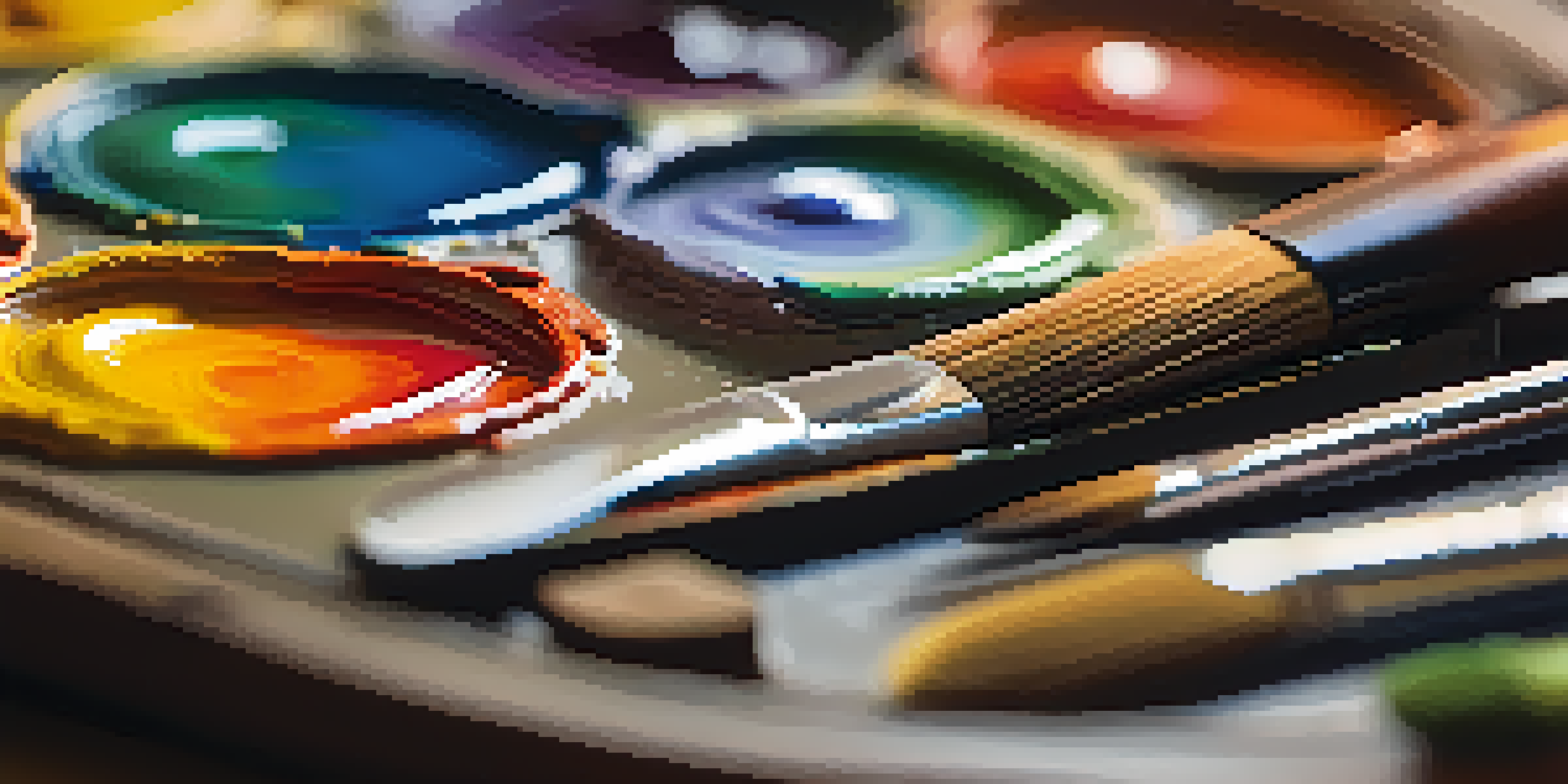Critique and Cultural Context: Understanding Paintings Better

The Importance of Art Critique in Understanding Paintings
Art critique serves as a lens through which we can better understand and appreciate paintings. It involves analyzing elements like composition, color, and technique to unravel the artist's intentions. By engaging in critique, we can cultivate a deeper emotional connection to the artwork, making our viewing experience richer and more fulfilling.
Art is not freedom from discipline, but disciplined freedom.
Imagine tasting a dish without knowing its ingredients; that’s what viewing art without critique feels like. A thorough critique not only highlights the technical aspects but also opens the door to understanding the story behind the painting. This process can transform a fleeting glance at a canvas into an enlightening journey through the artist's mind.
Moreover, critiques encourage dialogue and foster community among art enthusiasts. By sharing perspectives and interpretations, we create a vibrant discussion that can lead to new insights and appreciation. In essence, critique is not just about judgment—it's about exploration and connection.
Cultural Context: The Backbone of Artistic Interpretation
Cultural context refers to the social, political, and historical backdrop in which a painting is created. Understanding this context is essential because it informs the artist's message and intentions. For instance, a painting created during a time of war may convey themes of struggle and resilience that might be missed without this knowledge.

Consider famous works like Picasso's 'Guernica,' which powerfully reflects the horrors of war. Without knowing the political climate of the time, viewers may overlook the depth of the message. Cultural context acts as a key that unlocks the layers of meaning embedded within the artwork, revealing how it resonates with its time.
Art Critique Enhances Understanding
Engaging in art critique allows viewers to delve deeper into a painting's meaning, enriching their emotional connection to the artwork.
Furthermore, cultural context enriches our personal interpretation of art. Each viewer brings their own experiences and backgrounds, allowing for a unique understanding. This interplay between the painting and its cultural context creates a dynamic relationship that enhances our appreciation and emotional response.
Exploring Historical Influences on Artistic Movements
Art does not exist in a vacuum; it’s a reflection of the time in which it was created. Historical events, societal changes, and technological advancements can all influence artistic movements. For instance, the Impressionist movement emerged in response to the industrial revolution, capturing fleeting moments of everyday life.
Every artist dips his brush in his own soul, and paints his own nature into his pictures.
When we look at paintings from the Renaissance, for example, we see a focus on humanism and the beauty of the natural world. Understanding these historical influences allows us to appreciate the motivations behind certain styles and techniques. It’s like looking at a family tree—each branch tells a story of its own.
By recognizing these influences, we can better dissect and critique artwork from various periods. It transforms our viewing experience, turning it into a narrative journey through time. Ultimately, understanding historical influences helps us appreciate how art evolves and reflects humanity's collective experiences.
The Role of Personal Experience in Art Interpretation
Every viewer brings their own experiences, emotions, and perspectives to a painting, making personal interpretation a vital part of art appreciation. What resonates with one person may evoke a different response in another. This subjective nature of art means that there’s no singular 'correct' way to interpret a piece.
For example, a landscape painting might remind someone of a cherished childhood memory, while another viewer may see it as a representation of isolation. These divergent interpretations are what make art so powerful and relatable. It’s like a mirror reflecting our individual lives and emotions back at us.
Cultural Context Shapes Interpretation
Understanding the cultural context of a painting reveals the artist's intentions and enriches personal interpretations.
Engaging with art on a personal level enriches the viewing experience. It invites us to ask questions, explore our feelings, and share our interpretations with others. In this way, personal experience becomes a bridge connecting us to the artwork and to one another.
Using Art Critique to Foster Deeper Discussions
Art critique can serve as a catalyst for deeper discussions about a painting’s meaning and impact. When we critique art, we create an opportunity to share varied perspectives and insights. This collective exploration can lead to a more profound understanding of the work and the emotions it evokes.
Imagine gathering with friends to discuss a favorite painting. Each person offers their viewpoint, which might challenge or expand your own understanding. This exchange mirrors the larger conversations happening in the art world, where diverse voices contribute to the evolving narrative of art.
Ultimately, fostering discussions through critique helps demystify art and makes it more accessible to everyone. It encourages us to engage, ask questions, and appreciate the diversity of thought that art inspires. In a way, art critique is about building a community around shared experiences and ideas.
How to Approach Art Critique Effectively
Approaching art critique can feel daunting, but it doesn’t have to be. Start by observing the painting closely, paying attention to elements like color, composition, and texture. Ask yourself what emotions the piece evokes and what story it tells—this initial observation lays the groundwork for deeper analysis.
Next, consider the context in which the painting was created. Researching the artist's background, the historical period, and cultural influences can provide valuable insights. Think of it as detective work; the more clues you gather, the clearer the picture becomes.
Technology Broadens Art Accessibility
Advancements in technology facilitate greater engagement with art, enabling diverse discussions and collaborative critiques across platforms.
Finally, don’t shy away from sharing your thoughts and interpretations. Art is subjective, and your perspective is valid. Engaging in discussions with others can lead to new revelations and a richer understanding of the artwork, making the critique process not just informative but also enjoyable.
The Impact of Technology on Art Critique and Appreciation
Technology has revolutionized the way we interact with art, providing new tools for critique and appreciation. Online platforms allow art enthusiasts to share their interpretations, discuss techniques, and even attend virtual exhibitions. This accessibility encourages a wider audience to engage with art on various levels.
Social media, for instance, has created a space where artists and viewers can connect directly. Platforms like Instagram enable artists to showcase their work while receiving immediate feedback from followers. This instant interaction fosters a sense of community and encourages ongoing dialogue about artistic expression.

Moreover, technology allows for innovative ways to experience art, such as virtual reality tours of museums or interactive installations. These advancements not only enhance our appreciation of art but also broaden our understanding of its cultural significance. In this digital age, art critique becomes a collaborative and inclusive experience.